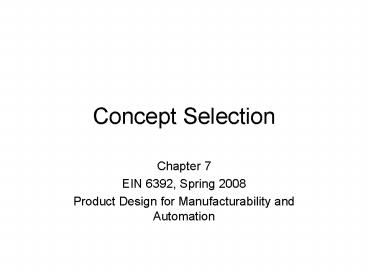Concept Selection - PowerPoint PPT Presentation
1 / 22
Title: Concept Selection
1
Concept Selection
- Chapter 7
- EIN 6392, Spring 2008
- Product Design for Manufacturability and
Automation
2
Product Design and Development
- 1. Introduction
- 2. Development Processes and Organizations
- 3. Product Planning
- 4. Identifying Customer Needs
- 5. Product Specifications
- 6. Concept Generation
- 7. Concept Selection
- 8. Concept Testing
- 9. Product Architecture
- 10. Industrial Design
- 11. Design for Manufacturing
- 12. Prototyping
- 13. Product Development Economics
- 14. Managing Projects
3
Concept Development Process
Mission Statement
Development Plan
Identify Customer Needs
Establish Target Specifications
Generate Product Concepts
Select Product Concept(s)
Set Final Specifications
Plan Downstream Development
Test Product Concept(s)
Perform Economic Analysis
Benchmark Competitive Products
Build and Test Models and Prototypes
4
Outline
- Concept selection approaches
- Concept selection process
- Concept screening
- Concept scoring
- Caveats
5
Definition
- A decision process, in which the design team
selects one or a few product concept for further
development
6
Concept selection approaches
- External decision
- Product champion
- Intuition
- Pros and cons
- Prototype and test
- Decision matrices
7
Concept Selection Process
- Prepare the Matrix
- Criteria
- Reference Concept
- Weighing
- Rate Concepts
- Scale (//0) or (15)
- Compare to Reference Concept or Values
- Rank Concepts
- Sum Weighted Scores
- Combine and Improve
- Remove Bad Features
- Combine Good Qualities
- Select Best Concept
- May Be More than One
- Beware of Average Concepts
- Reflect on the Process
- Continuous Improvement
8
Concept Development Funnel
9
Remember
- The goal of concept selection is not to
- Select the best concept.
- The goal of concept selection is to
- Develop the best concept.
- So remember to combine and refine the concepts to
develop better ones!
10
Two stages of concept selection
- Concept screening (the Pugh concept selection
method) - To quickly narrow the number of concepts and to
improve the concepts - Concept scoring
- weighs the relative importance of the selection
criteria - focus on more refined comparisons with respect to
each criterion
11
Concept screening steps
- Prepare a selection matrix based on the selection
criteria - Rate the concepts
- Rank the concepts
- Combine and improve concepts
- select one or more concepts
12
Concept screening principles
- Be focused on customer needs
- Match or exceed competitors performance along
key dimensions - Improve the products manufacturability
- Reduce lead time
- Encourage more and effective participation from
the design team members - Have better documentation of the decision
process.
13
Concept scoring method
- where
- wi the weight for the ith criterion
- rij raw rating of concept j for the ith
criterion
14
Issues in the decision process
- It assumes that the selection criteria reflect
customers needs - It assumes that the selection criteria are
independent - Manufacturing costs and manufacturability are not
included in the decision - It is better to directly evaluate those
independent, simpler concepts underpinning the
design concepts, if they constitute all the
product concepts. - The process of concept selection can be applied
to throughout the development process.
15
Concept Selection Example Reusable Syringe
16
Example Concept Screening
17
Example Concept Scoring
18
Concept Selection ExerciseMechanical Pencils
19
Mechanical Pencils Customer Needs
20
Mechanical PencilsConcept Selection Matrix
21
Retail Prices of Five Pencils
- Classic 2.75
- Quick Click 2.58
- Twist Erase 2.08
- Zézé 0.90
- Bic 0.33
22
Summary Caution
- Difficult to decompose the concept of quality
- Subjective criteria
- Systematically document concepts attributes that
can facilitate improving concepts. - Where to include cost
- Use of standard product configurations to
evaluate concepts at component levels - Repeat use of concept selection process as the
design process proceeds to more detailed levels.































